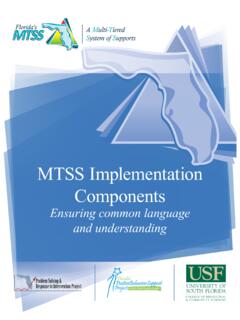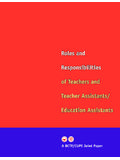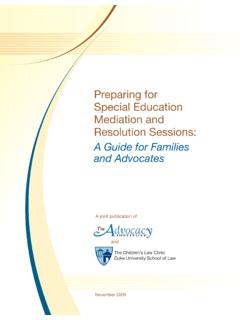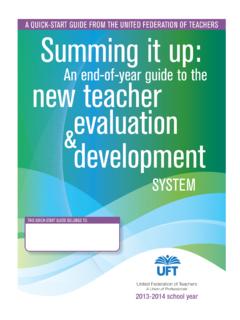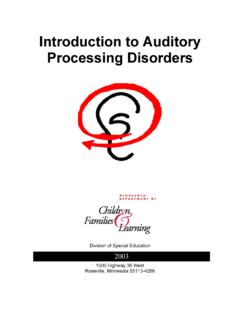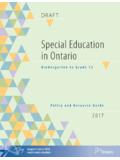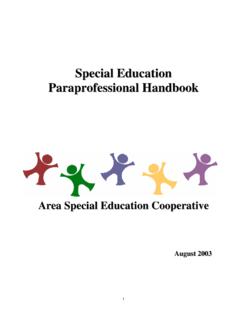Transcription of A Teacher’s Guide to Problem Solving Within the …
1 A teacher s Guide to Problem Solving Within the Multi-Tiered System of Supports Framework Florida Department of Education Bureau of Exceptional Education and Student Services 2010/2011 This is one of many publications available through the Bureau of Exceptional Education and Student Services, Florida Department of Education, designed to assist school districts, state agencies that support educational programs, and parents in the provision of special programs for exceptional students. This document is available online at For additional information on this publication, or for a list of available publications, contact: Clearinghouse Information Center Room 628, Turlington Building 325 West Gaines Street Tallahassee, Florida 32399-0400 Telephone: (850) 245-0477 Fax: (850) 245-0987 SunCom: 205-0477 E-mail: Web site: T MTSS and Problem Solving AAA TTTeeeaaaccchhheeerrr sss GGGuuuiiidddeee tttooo Problem Solving Within the Multi-Tiered System of Supports Florida Department of Education Bureau of Exceptional Education and Student Services 2011 This document was developed by PS/MTSS, a special project funded by the State of Florida, Department of Education, Division of Public Schools and Community Education, Bureau of Exceptional Education and Student Services, through federal assistance under the Individuals with Disabilities Education Act (IDEA), Part B.
2 Problem Solving /Response to Intervention Project University of South Florida 4202 East Fowler Ave, EDU 105 Tampa, FL 33620 Telephone: (813) 974-9499 Fax: (813) 974-7647 Web site: Copyright State of Florida Department of State 2011 Authorization for reproduction is hereby granted to the state system of public education consistent with section (2), Florida Statutes. No authorization is granted for distribution or reproduction outside the state system of public education without prior approval in writing. iii Contents Introduction: A teacher s Guide to Problem Solving 1 Chapter 1: Understanding the MTSS Process 2 Chapter 2: Define Problem Identification 8 Chapter 3: Analyze - Problem Analysis 10 Chapter 4: Implement Intervention Design 12 Chapter 5: Evaluate Response to Instruction/Intervention (MTSS) 16 Chapter 6: Connecting MTSS and Professional Development 18 Resources: Planning Documents 19 References 23 Table of Contents 1 Classroom Action Research AAA TTTeeeaaaccchhheeerrr sss GGGuuuiiidddeee tttooo Problem Solving Within a Multi-Tiered System of Supports A teacher s Guide to Problem Solving Within a Multi-Tiered System of Supports (MTSS) is a practical Guide to understanding the MTSS framework.
3 This was designed to assist teachers in building background knowledge of the Problem Solving process that occurs through MTSS in order to be a knowledgeable participant of the MTSS team. Classroom teachers are integral in this process as they are the primary providers of instruction and intervention. Positive learning outcomes for all students Within the MTSS framework are the responsibility of all school personnel as a team facilitates the Problem - Solving process. The team members may include students, parents, general educators, special educators, instructional coaches, administrators, ESE personnel (school psychologists, speech-language pathologists, occupational therapists), counselors, etc. State of Florida, Department of Education, Division of Public Schools and Community Education, Bureau of Exceptional Education and Student Services has also created the following resources focusing on the topic of MTSS: Florida Response to Intervention - Florida Introductory Online Training Course Problem Solving and Response to Intervention Project - Introduction 2 Chapter 1: Understanding the MTSS Process What is MTSS?
4 The Multi-Tiered System of Supports (MTSS) process is a three-tiered approach to providing quality instruction to meet the individual needs of all students. This model combines a standard system of assessment with high-quality instruction. Varying levels of interventions and services are designed for those students who are struggling. These levels are called tiers of instruction. The three tiers are on a continuum that is fluid, as the student s level of need dictates the level of support. This movement relies on careful decision making that occurs through deliberate data collection and thoughtful analysis facilitated by a school team including the classroom teacher . Additionally, MTSS may also help schools identify students who are eligible for an exceptional student education program. However, it is important to note that the goal of the MTSS framework is to expand and implement instructional alternatives, settings, and support systems before exceptional education services are considered.
5 The state of Florida adopts the definition of MTSS as the practice of (1) providing high-quality instruction/intervention matched to student needs and (2) using learning rate over time and level of performance to (3) make important educational decisions to Guide instruction (National Association of State Directors of Special Education, 2005). The MTSS model is a multi-tiered approach to providing high quality instruction and intervention matched to student needs, using learning rate over time and level of performance to inform instructional decisions. MTSS involves the systematic use of assessment data to most efficiently allocate resources in order to improve learning for all students. The essential components of MTSS include: Multiple tiers of evidence-based instruction service delivery. A Problem - Solving method designed to inform the development of interventions. An integrated data collection/assessment system to inform decisions at each tier of service delivery (Florida Problem Solving & Response to Intervention, 2008).
6 The Common Ground The basic elements of MTSS are required by the No Child Left Behind (NCLB) Act and the Individuals with Disabilities Education Act (IDEA); therefore, they are included in the broad-based initiatives for schools striving to meet Adequate Yearly Progress (AYP) such as Reading First, Florida s Continuous Improvement Model, Florida s Positive Behavior Supports, Problem Solving / MTSS State Pilot Project, and the Early Learning Success Initiative. Significant state initiatives have emerged since the enactment of the NCLB legislation. The Problem Although these initiatives share common core elements and goals for all Florida schools, they are Chapter 1 3 each facilitated by different offices Within the Department of Education that address specific content areas or stakeholder groups. Each set of efforts is built upon common elements, but with single-purpose resources and in segregated activities. Each separate effort also involves a unique set of terminology, professional development requirements, and data collection and reporting systems, which result in district and school personnel perceiving that an overwhelming number of parallel initiatives are either required or encouraged.
7 The Solution It is the recommendation of stakeholders that the Florida Department of Education unify its efforts and resources to maximize efficacy and elevate the common beliefs through mutual understanding of the principal foundation of MTSS and integration of that foundation throughout all statewide efforts and apply the principles of MTSS to a Multi-Tiered System of Supports for the students of Florida. How MTSS Practices Integrate Into The MTSS Framework Some of the key points in understanding how MTSS practices integrate into the MTSS framework are: The MTSS framework is an educational systems change paradigm (Sansosti & Noltemeyer, Annual 2008; Shores & Chester, 2009) that provides a framework for supporting students and staff as part of school improvement. MTSS begins in general education by establishing a strong core for all students that provides the foundation of prevention Within the entire system. MTSS includes PreK 12 literacy, mathematics, and behavior as a continuum of instruction.
8 The MTSS framework is inclusive to school accreditation and school improvement as well as school wide behavior programs (FL Positive Behavior Supports) and provides a common framework for schools to integrate efforts. Universal screening assessments used Within MTSS must measure the fluency and accuracy of critical early skills that are predictive of future student skill attainment. Tiers Within the triangle describe the intensity of instruction; not specific programs, students or staff ( , Title I, special education, etc.). The tiers describe instruction not steps in a process; therefore, students do not leave Tier 1 to receive instruction in Tier 2 or 3 nor must a student receive Tier 2 instruction prior to receiving Tier 3. The intensity of instruction (or tier of instruction required) is determined by the data. Students remain fluid Within the tiered instruction meaning intensity of instruction students receive should be transitioned up or down Within the tiers based on student performance over a set amount of time compared to predetermined decision points.
9 The MTSS framework is a hybrid model using both protocol interventions and Problem Solving . Tier 3 is not special education nor does student success/failure at Tier 3 determine eligibility for special education. In no way should MTSS delay the initial evaluation of a student that is suspected of having exceptionality. ~Adapted from the Kansas MTSS What are the goals for MTSS? The intent of MTSS is to ensure that students receive rich (learning) experiences every year in every setting with every teacher , not merely in some years in some settings with some teachers (Howard, 2009). With this said, the goal of MTSS is not to only look at the learner but also analyze and manipulate the learning environment, the curriculum being taught, and the instruction being delivered. The state of Florida identified goals of MTSS: 4 Modify instruction and implement scientifically-based interventions based on individual needs. The ultimate goal is student success in the form of increased academic achievement and positive behavior as early as possible.
10 Ensure that students difficulties are not due to lack of appropriate instruction. Identify student needs early. Make informed decisions about what resources are needed to ensure student success by closely monitoring student progress based on up-to-date data. What Does MTSS Look Like? Within the MTSS model, there are three levels of instruction and intervention called tiers. These three tiers use increasingly more intense instruction and interventions. Data is collected at each tier and is used to make instructional decisions to determine if students are responding to instruction and interventions. A Problem - Solving process is utilized to decide whether the instruction and interventions should be maintained and layered. Tier 1 instruction is the general education program. This means that ALL students are receiving core instruction with flexible grouping and differentiation. Screening and progress monitoring are utilized to determine instructional needs and measure student progress.
